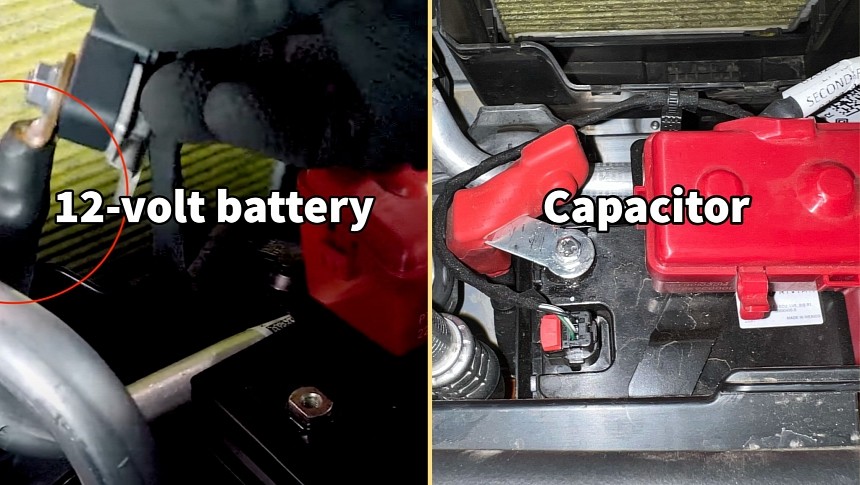Rivian recently faced a flurry of dying 12-volt batteries on its vehicles, last time because of a botched software update. This must have caused the EV startup a lot of money because it decided to replace one of the two 12-volt batteries with a capacitor.
Rivian is a young carmaker still learning new tricks about car manufacturing. The R1T and R1S turned out to be fantastic electric vehicles, especially for the first products from a new manufacturer. Still, they suffer from teething problems that others have already solved. One good example is Rivian's issues with the lead-acid 12-volt batteries. They are needed to power every electric system in a vehicle. They love spending time at 100% capacity, and they die prematurely if they are discharged.
Even when using deep-cycle batteries, discharging them below a certain point for an extended period shortens their life significantly. This has become obvious in electric vehicles, which use smaller low-voltage batteries. They don't have to start the engine, so there's no need for a high-current battery. On the other hand, they can get discharged when an EV spends more time unused. The 12-volt battery is supposed to be charged from the high-voltage battery, but if the latter drops below a certain SoC, it won't charge the 12-volt battery anymore.
As the leading EV maker, Tesla noticed that lead-acid batteries have a high rate of failure and decided to switch to Li-ion batteries instead. The move solved the dying battery issues, so Tesla only makes EVs with Li-ion batteries now. Of course, there's a debate about why EVs need 12-volt batteries in the first place, considering that a big battery pack is there anyway. The short answer is safety, as the high-voltage battery needs to be safely disconnected from the car's electrical systems in certain situations, including crashes. In that case, the 12-volt battery will continue to power the car's systems.
Rivian faced a massive problem in March after the 2023.6.2 update broke the connection between the high-voltage and 12-volt batteries. This made the low-voltage batteries die, leaving Rivian with huge replacement bills. The electrical system in R1S and R1T vehicles uses a unique configuration, with two small 12-volt batteries instead of just one. Rivian probably opted for this setup to optimize the space under the hood, as the two batteries fit perfectly between the frunk base and the cabin filter.
Rivian is taking optimization to another level, replacing the passenger-side battery with a capacitor. Ryan Huber, a member of the Rivian Forums, discovered this after his R1S's battery died. When he attempted to jump-start it, Ryan noticed that the passenger side "battery" would not hold a charge, so he called the service center. The service center technician confirmed his car has only one 12-volt battery, and a capacitor has replaced the second one.
It still looks identical to the battery next to it, although it has a red cable lead on the left instead of a black one of the real battery. The problem is that the Rivian owner's manual still talks about a dual-battery setup and offers information about how to jump-start both. Hopefully, Rivian will document this change and provide the electrical diagram so that third-party suppliers will not mess things up.
Even when using deep-cycle batteries, discharging them below a certain point for an extended period shortens their life significantly. This has become obvious in electric vehicles, which use smaller low-voltage batteries. They don't have to start the engine, so there's no need for a high-current battery. On the other hand, they can get discharged when an EV spends more time unused. The 12-volt battery is supposed to be charged from the high-voltage battery, but if the latter drops below a certain SoC, it won't charge the 12-volt battery anymore.
As the leading EV maker, Tesla noticed that lead-acid batteries have a high rate of failure and decided to switch to Li-ion batteries instead. The move solved the dying battery issues, so Tesla only makes EVs with Li-ion batteries now. Of course, there's a debate about why EVs need 12-volt batteries in the first place, considering that a big battery pack is there anyway. The short answer is safety, as the high-voltage battery needs to be safely disconnected from the car's electrical systems in certain situations, including crashes. In that case, the 12-volt battery will continue to power the car's systems.
Rivian faced a massive problem in March after the 2023.6.2 update broke the connection between the high-voltage and 12-volt batteries. This made the low-voltage batteries die, leaving Rivian with huge replacement bills. The electrical system in R1S and R1T vehicles uses a unique configuration, with two small 12-volt batteries instead of just one. Rivian probably opted for this setup to optimize the space under the hood, as the two batteries fit perfectly between the frunk base and the cabin filter.
Rivian is taking optimization to another level, replacing the passenger-side battery with a capacitor. Ryan Huber, a member of the Rivian Forums, discovered this after his R1S's battery died. When he attempted to jump-start it, Ryan noticed that the passenger side "battery" would not hold a charge, so he called the service center. The service center technician confirmed his car has only one 12-volt battery, and a capacitor has replaced the second one.
It still looks identical to the battery next to it, although it has a red cable lead on the left instead of a black one of the real battery. The problem is that the Rivian owner's manual still talks about a dual-battery setup and offers information about how to jump-start both. Hopefully, Rivian will document this change and provide the electrical diagram so that third-party suppliers will not mess things up.








